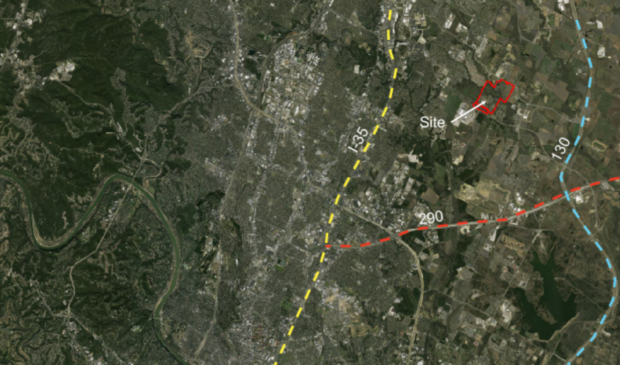Pioneer Crossing PUD changes course, adding parkland
Monday, October 7, 2019 by
Jessi Devenyns Having passed through and received an approval recommendation from the Zoning and Platting Commission on Sept. 17 for its 14th amendment, the Pioneer Crossing planned unit development arrived at the Environmental Commission on Oct. 2.
A 376-acre portion of the 1,410-acre site sits at 3124 E. Parmer Lane where developers are requesting to reallocate the residential portion of the PUD as well as increase the height up to 75 feet, or six stories. They also requested that an adjacent parcel of the PUD have its height maximum increased to 60 feet.
In exchange, Michael Whellan, an attorney who was representing the applicant, told the commissioners that the development would open 100 acres of publicly accessible, privately maintained park space. This parcel of the development currently has seven acres of dedicated parkland.
This additional acreage is available thanks to a staff condition that prevents golf courses in the area. According to Atha Phillips with the Watershed Protection Department, the land was previously intended for a golf course, but as part of the recommendation for the change, staffers are asking the developer to “remove all references to golf course and golf cart trails from 2005 PUD ordinance.”
Commissioners were encouraged by the idea of opening up such a large swath of space for local residents in what Commissioner Katie Coyne said was a park-poor area. However, she asked if there were any guarantees that the land would remain a park in perpetuity.
“I can’t see them putting a giant fence around the whole thing, but you never know,” Phillips said.
Whellan noted that while the park will be privately maintained, it is listed as a park in a zoning ordinance attached to the PUD and so it would have to be a decision from the city to revoke public access.
In order to prevent the park from simply becoming open green space with no improvements or amenities, the Environmental Commission began listing recommendations for consideration by Council. These included using only outdoor lighting fixtures that adhere to the Dark Skies Ordinance, which prompted commissioners to suggest that park hours be limited from dawn until dusk. The commission also recommended that the developers consider using reclaimed water for irrigation and abide by the modern heritage tree ordinance. The site is currently only subject to Austin’s 1997 version of a tree ordinance.
Commissioner Wendy Gordon cautioned the commission to use blanket statements so as not to micromanage and rather require the developer to consult with the Parks and Recreation Department on specific amenity requirements. “We’re not the park experts,” she said.
Nevertheless, Coyne took a moment at the meeting to forward the parks department and watershed staff a copy of the Healthy Parks Plan for the area to demonstrate the community health needs that could be addressed with a park. The study was done by the St. David’s Foundation to show the community health benefits of having accessible parks.
Coyne encouraged staff to use the study to “have an influence on the way you make decisions on what kind of programs you have in your parks.”
Generally, the process is reversed, but the amendment originally bypassed the Environmental Commission and went straight to Zoning and Platting, where members asked for the environmental expertise on the plan. To oblige the request of the land use commission, Environmental Officer Chris Herrington redirected the case to the Environmental Commission for review before it arrived before Council.
After over an hour of discussion, the commission unanimously recommended the change for approval by Council. Commissioners Curtis Smith and Andrew Creel were absent.
While this amendment will be arriving before Council for a vote on Oct. 17, a 15th amendment is already making its way through the commissions to donate even more parkland from this development to the surrounding citizenry.
Map courtesy of the city of Austin.
The Austin Monitor’s work is made possible by donations from the community. Though our reporting covers donors from time to time, we are careful to keep business and editorial efforts separate while maintaining transparency. A complete list of donors is available here, and our code of ethics is explained here.
You're a community leader
And we’re honored you look to us for serious, in-depth news. You know a strong community needs local and dedicated watchdog reporting. We’re here for you and that won’t change. Now will you take the powerful next step and support our nonprofit news organization?









